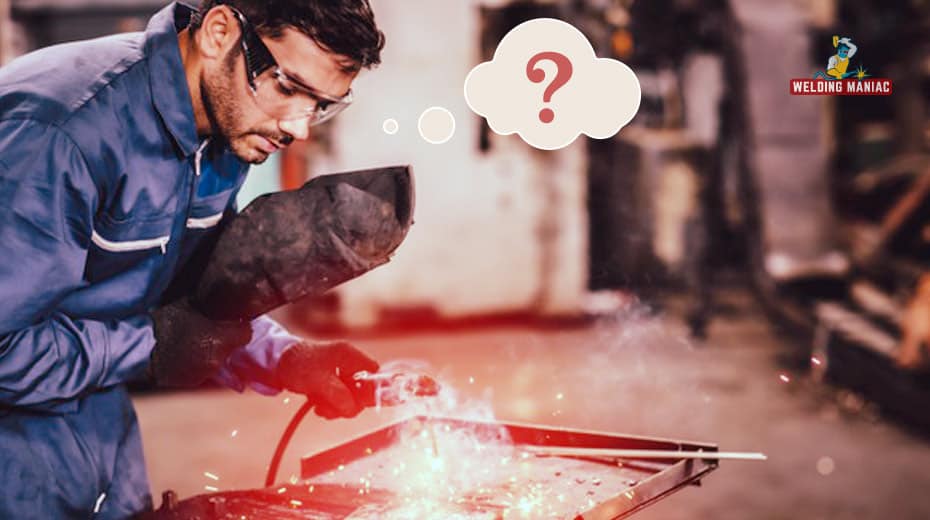You die as soon as you stop learning! Doesn’t matter if you are just starting or are a welding ninja, you gotta have some questions. In this Welding FAQ Guide, I have tried to accumulate all the questions that I have come across over my career, from newbies to pros! I will keep updating this blog post from time to time!
What is Welding?
Welding is the act of joining two or more metal parts together using heat. Here the metals to be joined, occasionally, with a filler metal are heated to the melting point to form a joint. There are a myriad of methods available for welding. You can take welding as either a hobby or a profession.
What is Stick Welding?
Stick welding is an electric arc welding process, a.k.a., SMAW (Shielded Metal Arc Welding) or MMA (Manual Metal Arc Welding), that uses a consumable electrode rod (welding rod), that is covered with a flux material. While welding the flux releases shielding gases that protect the weld, and hence comes the name.
While in action the flux coating is vaporized and forms a gaseous shield around the molten metal to protect it from the oxides and nitrides in the air. A layer of slag covers the finished weld while it solidifies and is removed when the base metal cools.
The finished work is not neat, to be honest, and you will want to do stick welding for outdoor works and in places where a neat finish is not required, like in pipeline welding, construction, farms, etc.
What is MIG Welding?
MIG (Metal Inert Gas) welding, a.k.a. Gas Metal Arc Welding is arguably the easiest welding process to start with.
In MIG welding solid wire is continuously fed through a welding gun upon pulling the trigger. An electric arc is created during the process and heat is produced above the melting point of both the base metal and the electrode. Both the working piece and filler metal melts and forms a strong joint. The shielding gas supplied externally protects the molten metal from reacting with the oxides, nitrides, water vapor, and other things in the atmosphere. The most commonly used gas is carbon dioxide (CO2) or a mixture of argon (Ar) and carbon dioxide (CO2).
You have polarity, wire speed, and voltage controls on the machine. The trigger acts as an on-off switch. MIG is a consumable electrode process. It always adds filler metal to the joint.
MIG welding can be used to weld a wide range of alloys including carbon steel, stainless steel, silicon bronze, aluminum, and others. This GMAW process is well suited for sheet metal welding, automotive and home improvement industry, and similar.
What is TIG Welding?
TIG (Tungsten Inert Gas) welding, a.k.a., Gas Tungsten Arc Welding (GTAW) is a non-consumable electrode process where the tungsten electrode is used to create an arc that heats up the base metal beyond its melting point and to create a molten weld puddle which in turn creates strong weld joint.
TIG works by melting the base metal. Although it is not essential to use fillers in TIG, an external filler rod can be added into the molten weld metal to form strong welds. You can control the heat with a foot pedal or with a thumbwheel on the torch. While TIG welding you will want to use a shielding gas, most commonly Argon, but Helium is also used to protect the molten weld pool.
TIG welding finds its applications in different industries than any other type of welding. These include piping systems welding, aerospace welding, and sheet metal welding industries when welding particularly thin materials and special materials such as titanium.
What is Arc Welding?
Arc welding a.k.a. flux-cored arc welding produces an electric arc to melt the base metal and optionally a continuously fed electrode to form a metal bonding. A tubular wire filled with flux is used instead of a solid wire and hence, comes the name flux-cored.
There are two types of flux-cored wire available, one is self-shielded and the other is dual shielded. The difference between these two is that the former depends on external gas supply and the latter one doesn’t. Either carbon dioxide or argon and carbon dioxide mixes are used as shielding gas. If you are working outside or in windy situations, you will want self-shielded wires.
How do you Finish the Welds?
Finishing of the welding process depends primarily on individual customer requirements and the levels of spatter produced during the welding job and the material you are welding. You need to prepare the surface for painting. Typically it involves grinding, blending, descaling, polishing for beautiful welds.
Can you become a Welder over 40?
There ain’t any age restriction, not that I know of. If you are in good health and can fulfill the certificate requirements which is even optional in some states and industries, you are good to go! The better the hand-eye combination you got, the better the welder you will become.
Is Welding a good career choice?
Welding is certainly a good career choice, I will put my money on that. Lots of people are joining the trade nowadays and for good reasons! Although it depends on your individual preferences, interests, and life goals, I will recommend you read this article before making any decisions.
Can I join two metals without Welding?
There are plenty of ways to join two metals without using a welder. Namely, Epoxy, Soldering, Spot welding, Brazing, Riveting, and many more.

